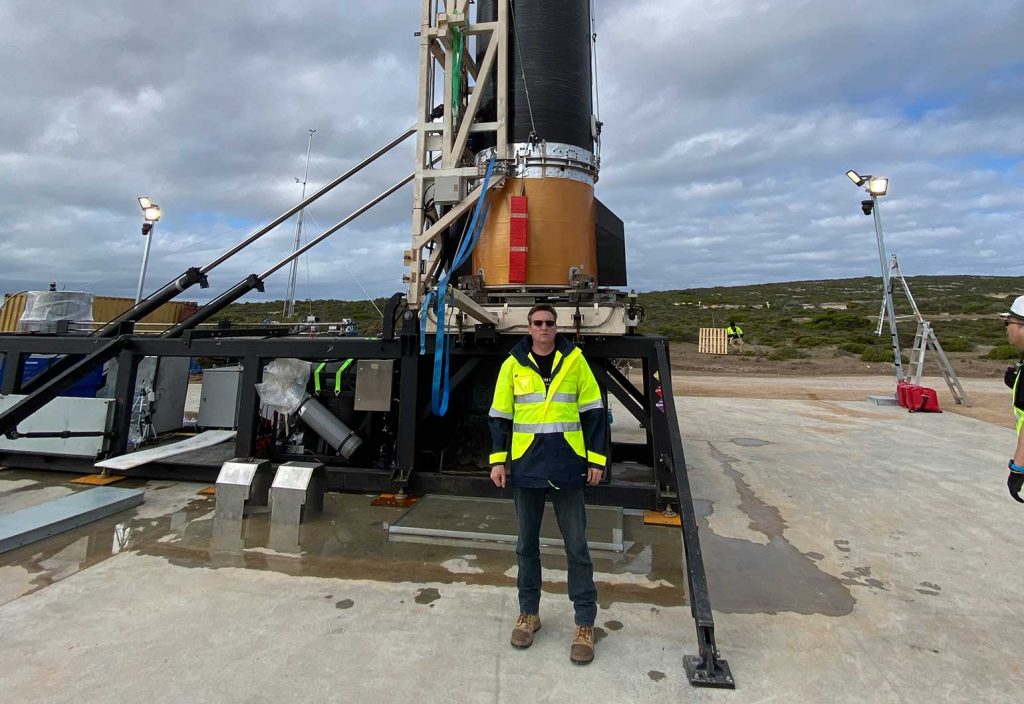After serving in the army and as an undercover police officer, Engineers Australia member Andrew Curran MIEAust decided to pursue engineering as a mature age student — even while he was living in witness protection. He’s now working to develop Australia’s first private launch space launch facility.
Curran grew up on farms in Victoria and New South Wales, before serving in the Australian Army for three years and then joining the NSW Police. There, he served 10 years, almost four of them as an undercover police operative involved in the covert investigation of major crimes such as murder, armed robbery and drug supply.
He received honours in civil and structural engineering at the University of Southern Queensland. During his studies, Curran and his young family were required to go into witness protection due to his past undercover work with NSW Police. After graduating, he worked for a number of firms in Australia and overseas before joining space company Southern Launch as general manager in February 2020.
Curran, who is Engineers Australia’s South Australian Professional Engineer of the Year, spoke with create about his remarkable career.
“All of the different roles I have undertaken in my life have involved service to the greater community: farming, army and the police,” he said. “Engineers serve the greater good for the community; we are one of the noble professions. I get a lot of satisfaction from that service.”
Curran also found appeal in his career options, such as working overseas and choosing between management and technical roles — not to mention a better quality of life than his previous careers.
“Upon graduating, I worked for three engineering firms — Young Consulting Engineers, Maunsell Australia and GHD — before I received an offer to work in Saudi Arabia,” he said. “I worked in client-side project direction in Saudi Arabia from 2008 until 2016.
“There, I had the opportunity to work on projects throughout the six Gulf Cooperation Council nations, including mega projects valued between US$10 and US$90 billion, such as the King Abdullah Financial City and the Riyadh Metro. It was an amazing experience for myself and for my family.”
International challenges
Curran said that from an engineering perspective, his time working in the Gulf countries exposed him to a broad range of standards and working cultures — and at times — difficulties in navigating them.

“The language barrier was a really interesting challenge. On any project, you might have a mixture of African nationals, Indian, Pakistani, Bangladeshi, a mixture of Arab nationalities, Saudis with all sorts of different roles — not everyone was able to speak one particular language,” he said.
“Safety on large projects was exactly as you would expect in Australia or America or Britain. But for smaller projects, there were sometimes challenges.
“Ensuring everyone goes home every day is without a doubt the most important duty of every engineer.”
The space race
Curran said that, without a doubt, his proudest achievement — and the most challenging — is his current project: obtaining the development application for the Whalers Way Orbital Launch Complex.
“Civil engineers generally don’t want to be the first to try something new — you want to use tried and true materials and tried and true methodologies,” he said. “This project has been first after first after first. We’re the first private company in Australia to undertake an environmental impact study in order to build a rocket launch facility, and we have been working on it for over two years.”
Curran added that the South Australian government was open with Southern Launch that initially it was not sure how to assess the project due to its unique nature.
“Obviously, the focus is mainly on ecology, but there’s also air and water quality, noise, and so on. No one has worked on a development approval for a rocket launch facility before, so we’ve had to develop a number of analysis methodologies which haven’t been used in Australia,” he said.
“For example, you would normally assess noise impact from a project over a period of time, whereas we only generate noise realistically for about 90 seconds once every two or three weeks.
“A very real challenge was the lack of empirical data in relation to the impacts of launches on native fauna. We developed a three launch test campaign to produce this data. A test campaign such as this had never been done in Australia before.”
As part of his role, Curran is also heading back to university to complete a PhD through the University of Southern Queensland. His research is into the infrastructure requirements associated with the launch of small, mini and micro rockets.
“I’ve wanted to do a PhD since I was at university. There’s not that much literature out there on the work we’re doing, so there’s an opportunity to develop a thesis which will be of use to the community,” he said.
The Engineer of the Year 2021 winners will be announced 1 March. To view the full list of finalists, visit our awards website.
